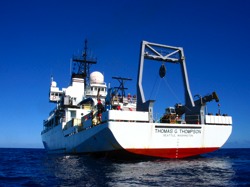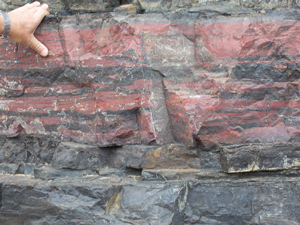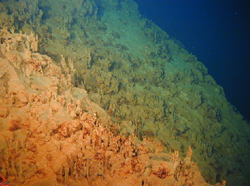FeMO3 Dive Cruise 2008
Report -- Orders of Magnitude and Banded Iron Formations
FeMO3 Dive Cruise 2008 |

Sitting out here on the R/V Thompson it feels like we are a little dot in middle of the vast Pacific Ocean and it makes me think about the scale of things. It seems ironic that we are using 2,000,000,000g ship to operate a 3,700,000g submersible to hunt a bacterium that weighs only 0.000000000001g. This is a remarkable range of scale. If we think of this in powers of 10, it is 1022 orders of magnitude (1 followed by 22 zeros) difference between the weight of our ship and the question we are after. To think of it in length instead of weight, the ship is 85 meters long and the bacterium is 0.0000003 meters long, a difference of 109 so the bacterium is approximately a billion times smaller than the ship we are using to hunt it. Why should we pursue such small creatures with such a large ship?

So lets try one convoluted explanation. It is interesting that our ship is made out of steel and steel is made mainly from iron. So now consider if there was no iron to produce steel for building ships, or that steel cost as much as aluminum (at least 5 times the price), which is used to make airplanes. Aluminum is actually the third most abundant element in the Earth’s crust, while iron is the fourth. While it might be possible to build a medium sized ship like the Thompson from wood or fiberglas or aluminum, it would be very challenging and expensive, and it would not be possible to build the really large ships like freighters, oil tankers, air craft carriers or big cruise ships. Now consider the effects on society and the global economy if we could not ship large amounts of goods or energy cheaply on steel ships across the world’s oceans. So why is steel cheap? An important reason is because the iron that it is produced from is cheap to mine. The reason for this is that the ore from an iron mine is highly concentrated in iron oxides. Several hundred pounds of iron can be extracted from every ton of iron ore that is removed from the ground, making it quite efficient, hence cheap. By contrast, it takes several tons of ore to produce an ounce of gold. So why is iron so concentrated in the places it is mined?

We know that for at least the first half of Earth’s history there was very little oxygen in the atmosphere. One result of this was that there was much more soluble iron (ferrous iron) in the ocean than there is today. This is because oxygen reacts rapidly with ferrous iron causing it oxidize to ferric iron (rust) and precipitate as an iron oxide. We believe that there were episodes in Earth’s past (as recently as several hundred million years ago) when the ferrous iron in the ocean was oxidized and precipitated quite rapidly to form concentrated ores over significant areas, perhaps covering entire shallow ocean basins. These deposits are called banded iron formations and have a unique stratified appearance, containing different iron oxides. It are these iron ores that we mine today.

So finally this story comes back to our tiny bacteria that live by eating iron. There is growing speculation that bacteria capable of gaining energy from the oxidation of iron, like the ones we are studying at Loihi, may have been responsible for accumulation of the concentrated iron oxides in the banded iron formations that we mine today. This is the iron that goes into making the steel that goes into making the hulls of the ships which we sail out into the ocean to study these bacteria. It is a source of amazement to think that these tiny organisms by virtue of their large numbers, unique metabolism, and perseverance over millions of years, could create the massive deposits of iron ore that we exploit today. And it is a source of some humility to think that the iron our ship is made of, may have, at one time, been food for bacteria like the ones we are hunting today at Loihi.
| FeMO3 Cruise Home Page |